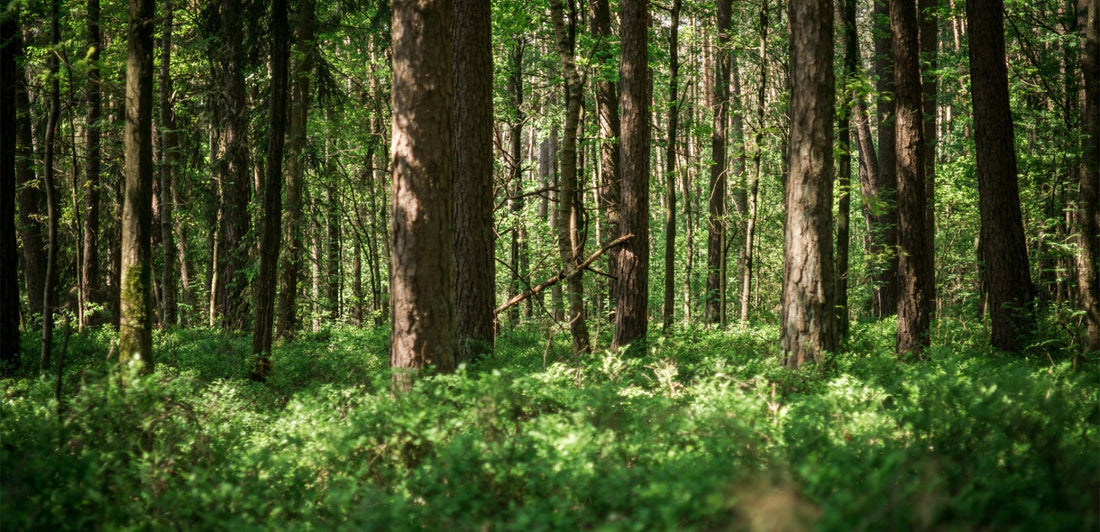Why wouldn’t TWOTHIRDS use a material that is super soft, cheap to produce, and comes from trees? Well, while viscose has ecological roots and is among fashion’s most popular alternatives to silk, its unregulated production can have serious environmental and social ramifications. Some things are just too good to be true.
Viscose is made from the pulp of fast-growing trees like beech, pìne, or eucalyptus. During the manufacturing process the wood pulp is chemically treated with hazardous substances, such as carbon disulfide, sodium hydroxide, and sulfuric acid, to convert it into viscose fibers. Viscose’s chemical-intensive process raises various environmental and social issues.
Why We Avoid Conventional Viscose
Deforestation
The sourcing of wood pulp can contribute to deforestation and habitat loss, which impacts biodiversity and exacerbates climate change.
An investigation by NBC news found that, in the early 2000s, vast swathes of South-East Asian rainforest were cut down to make space for incoming tree farms that supplied viscose producers with their raw material.
The result is a monoculture. Where once hundreds of plant and tree species thrived, now only one dominates, which is not just devastating to the natural ecosystem but also leads to a loss of carbon drawdown because “an acre of tree farm doesn’t absorb nearly as much carbon dioxide as an acre of rainforest.”
Chemical Pollution
The manufacturing process releases harmful chemicals into the air and water, potentially harming nearby communities and ecosystems. 3 of the chemicals required to produce viscose pose severe health risks to workers. While sodium hydroxide can cause burns, carbon disulfide has been linked to spikes in the incidence of heart disease, birth defects and cancer not just among workers but in the communities that surround viscose factories.
Water Consumption
Viscose production is water-intensive, which can strain water resources in regions where it is produced. This is a deal breaker for TWOTHIRDS as we actively seek out materials that have a lower water footprint. According to a 2017 report, one tonne of viscose typically requires 3,000 cubic metres of water. This balloons to 30,000 cubic metres if the factory deems it necessary to use “continuous washing” methods.
Waste And Emissions
Viscose’s chemical treatment process generates waste and greenhouse gas emissions, due to the high amount of energy that’s required for the task at hand. Also, viscose products are not typically the most durable which can in turn contribute to fashion’s enormous waste problem. Thankfully, viscose is biodegradable if treated correctly.
This gives us 4 compelling reasons not to use conventional viscose rayon. We see it as ethically compromised, damaging to rainforests as well as the animals and communities that rely upon them, and another facet of fashion that contributes to global warming / boiling.
The Exception To The Rule: LENZING™ ECOVERO™ Viscose
So, when we said we don’t use viscose, we weren’t telling the whole truth! Thanks to a revolutionary fiber from EU-headquartered Lenzing AG, we’re able to get all the good from viscose (its softness, its renewability, its versatility) without the serious knock-on effects.
LENZING™ ECOVERO™ viscose is so much better than regular viscose it received a prestigious EU EcoLabel award, which signifies compliance with rigorous environmental standards set by the European Union regarding the entire lifecycle of a product. This acknowledges Lenzing’s use of certified sustainably managed forests; its outright avoidance of tree types that are classed as endangered or ancient; and its effective use of a revolutionary closed loop system. Crucially, Lenzing biorefineries capture and reuse 99% of the potentially hazardous chemicals linked to the dissolving process, making it safe for workers and more environmentally friendly. It’s considered a “certified eco-responsible” type of viscose.
According to the Higg MSI tools, LENZING™ ECOVERO™ viscose produces up to 50% fewer emissions than conventional viscose and requires 50% less water too.
The entire manufacturing process behind LENZING™ ECOVERO™ Viscose has been designed to improve efficiency and sustainability, helping to shift the fashion industry away from the destruction of rainforests and towards clean, green solutions.

LENZING™ ECOVERO™ viscose can be found in some of our most popular late summer styles, as well as our beautiful loungewear. It is our go-to material for summer-y silkiness, comparable to another fan favourite that has botanical origins, TENCEL™ Lyocell. LENZING™ ECOVERO™ viscose also tends to star in our women’s dresses, responding extremely well to our digital printing techniques.
There are other occasions when we might use viscose, like when it’s part of a recycled yarn or a deadstock fabric (though the majority of our deadstock is cotton). But for the most part LENZING™ ECOVERO™ viscose continues to be our preferred sustainable alternative.
Tree-based fibers can be eco-friendly when produced in the right way. LENZING™ ECOVERO™ viscose offers TWOTHIRDS a way of taking the magic of photosynthesis and transforming it into garments that last. When the time comes, LENZING™ ECOVERO™ viscose will, of course, biodegrade in marine and land conditions.
LENZING™, ECOVERO™ and TENCEL™ are trademarks of LENZING AG.









